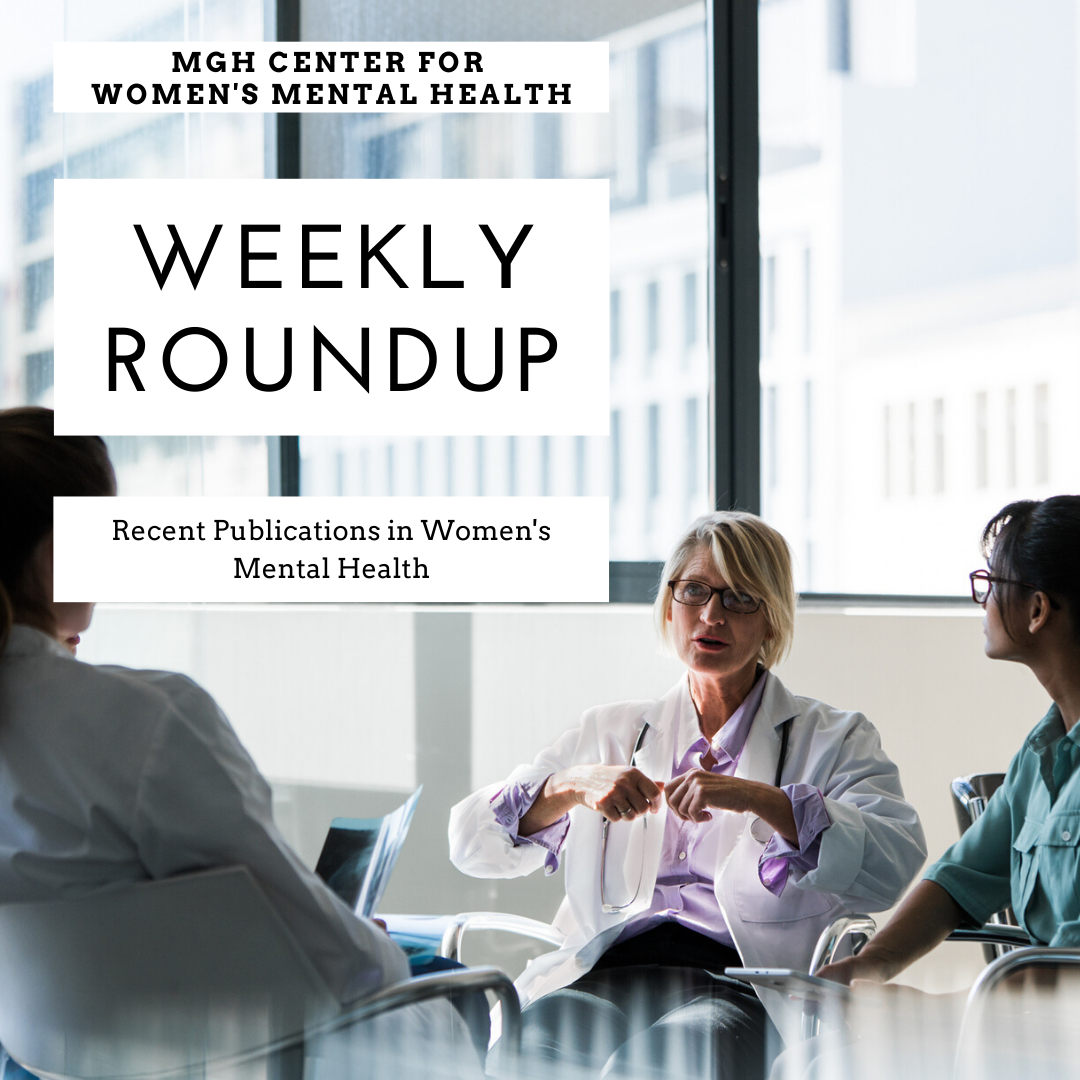Every week we review the most recent publications in women’s mental health, covering topics related to premenstrual symptoms, perinatal mood and anxiety disorders, use of medications in pregnant and breastfeeding women, perinatal substance use, and menopausal mental health.
In a randomized controlled trial, bright light therapy was no more effective than placebo (dim red light) for the treatment of depression during pregnancy. One the other hand, other RCTs have shown that bright light therapy is effective in this setting.
If you are interested in looking at the microbiome and its role in PPD, there is an article from Zhou and colleagues demonstrating that the pattern of microbiota in the guts of women with PPD differs from the guts of healthy controls. What is not so clear is whether this change in the microbiome is a result of depression in the mother, or whether the changes in the microbiome somehow confer vulnerability to depression.
And there is an interesting series of articles detailing the findings of a prospective, intergenerational cohort study from Australia looking at the role of preconception mental health issues and risk for adverse pregnancy outcomes and parent-child bonding.
For more detailed descriptions of many of these topics, you can sign up to receive our weekly CWMH NEWSLETTER which comes out every Thursday.
Ruta Nonacs, MD PhD
PMS AND PMDD |
| No articles this week
|
INFERTILITY AND MENTAL HEALTH |
| Influence of COVID-19 pandemic on the psychological status of infertile couples.
Esposito V, Rania E, Lico D, Pedri S, Fiorenza A, Strati MF, Conforti A, Marrone V, Carosso A, Revelli A, Zullo F, Di Carlo C, Venturella R. Eur J Obstet Gynecol Reprod Biol. 2020 Oct;253:148-153. Free article. The COVID-19 lock-down had a moderate/severe psychological impact on infertile patients (mean IES-R score 36.4 ± 16.6). The mean STAI score was 49.8 ± 15.3, with an overall incidence of STAI > 36 of 71 %. Women were more emotionally distressed, anxious and depressed than men (36.8 ± 16.4 vs 31.0 ± 18.4 for IES-R, respectively; p = 0.03).
|
PSYCHIATRIC ILLNESS DURING PREGNANCY |
| Effects of bright light therapy for depression during pregnancy: a randomised, double-blind controlled trial.
Bais B, Kamperman AM, Bijma HH, Hoogendijk WJ, Souman JL, Knijff E, Lambregtse-van den Berg MP. BMJ Open. 2020 Oct 28;10(10):e038030. Free article. Participants were randomly allocated to treatment with either bright light therapy (9000 lux, 5000 K) or dim red light therapy (DRLT, 100 lux, 2700 K), which is considered placebo. Depressive symptoms of pregnant women with depression improved in both treatment arms. Insomnia symptoms during pregnancy: A meta-analysis. Sedov ID, Anderson NJ, Dhillon AK, Tomfohr-Madsen LM. J Sleep Res. 2020 Nov 2:e13207. Review. The overall prevalence of insomnia symptoms during pregnancy was 38.2%. Trimester was a significant moderator, such that prevalence of insomnia symptoms was higher in the third trimester (39.7%) compared to first (25.3%) and second (27.2%) trimesters. COVID-19 pandemic and maternal mental health: a systematic review and meta-analysis. Hessami K, Romanelli C, Chiurazzi M, Cozzolino M. J Matern Fetal Neonatal Med. 2020 Nov 1:1-8. Eight studies reported depressive and anxiety states of 7750 women, either pregnant or postpartum were included.COVID-19 pandemic significantly increases the risk of anxiety among women during pregnancy and perinatal period. Salameh TN, Hall LA. Issues Ment Health Nurs. 2020 Jan;41(1):7-23. Three studies identified an increase in antidepressant use from 1995 to 2010 in pregnant women. Nine of 19 population-based studies revealed that White ethnicity, older reproductive age, college education, and health insurance coverage were associated with mental health and substance use treatment receipt among pregnant women. van Lee L, Chia A, Phua D, Colega M, Padmapriya N, Bernard JY, Cai S, Tham EKH, Teoh OH, Goh D, Gooley JJ, Gluckman PD, Yap F, Shek LPC, Godfrey KM, Tan KH, Chong YS, Müller-Riemenschneider F, Broekman B, Meaney M, Chen H, Chong MFF. Compr Psychiatry. 2020 Sep 30;103:152210. Pregnant women with ?4 lifestyle risk factors showed a higher prevalence of depression during pregnancy, while no associations were observed for postpartum depression.
|
MEDICATIONS AND PREGNANCY |
| No articles this week
|
POSTPARTUM PSYCHIATRIC ILLNESS |
| Fecal Microbiota Changes in Patients With Postpartum Depressive Disorder.
Zhou Y, Chen C, Yu H, Yang Z. Front Cell Infect Microbiol. 2020 Sep 29;10:567268. Free article. The levels of several predominant genera were significantly different between PPD patients and HCs. PPD patients experienced reduced levels of Faecalibacterium, Phascolarctobacterium, Butyricicoccus, and Lachnospiraceae, as well as increased levels of Enterobacteriaceae family. In addition, a correlation was observed between levels of Phascolarctobacterium, Lachnospiraceae, Faecalibacterium, and Tyzzerella.3 and the severity of depressive symptoms. |
| Trajectories of Maternal Postpartum Depressive Symptoms.
Putnick DL, Sundaram R, Bell EM, Ghassabian A, Goldstein RB, Robinson SL, Vafai Y, Gilman SE, Yeung E. Pediatrics. 2020 Nov;146(5). One-quarter of mothers in a population-based birth cohort had elevated depressive symptoms in 3 years postpartum. Four depression trajectories were identified: low-stable (74.7%), characterized by low symptoms at all waves; low-increasing (8.2%), characterized by initially low but increasing symptoms; medium-decreasing (12.6%), characterized by initially moderate but remitting symptoms; and high-persistent (4.5%), characterized by high symptoms at all waves. |
| Unplanned Cesarean delivery is associated with risk for postpartum depressive symptoms in the immediate postpartum period.
Smithson S, Mirocha J, Horgan R, Graebe R, Massaro R, Accortt E. J Matern Fetal Neonatal Med. 2020 Oct 27:1-7. Unplanned CD was significantly associated with PPD risk (OR = 2.28, 95% CI 1.13-4.57, p = .022), after adjusting for parity and race/ethnicity. Planned CD was not associated with PPD risk. |
| Does premenstrual syndrome before pregnancy increase the risk of postpartum depression? Findings from the Australian Longitudinal Study on Women’s Health.
Cao S, Jones M, Tooth L, Mishra G. J Affect Disord. 2020 Oct 6;279:143-148. During 15 years’ follow-up, 15.4% of participating women reported PPD; and 55.1% reported PMS (rarely: 17.2%, sometimes: 25.7%, and often: 12.2%). Compared to women who had no PMS before pregnancy, those who rarely had PMS had similar risk of PPD (1.03, 0.82-1.30); whereas those who sometimes or often had PMS had significantly higher risk of PPD (1.31, 1.09-1.57 and 1.51, 1.22-1.87, respectively). History of depression did not affect the association. |
| Risk for probable post-partum depression among women during the COVID-19 pandemic.
Pariente G, Wissotzky Broder O, Sheiner E, Lanxner Battat T, Mazor E, Yaniv Salem S, Kosef T, Wainstock T. Arch Womens Ment Health. 2020 Oct 12:1-7. Free article. In our population, delivering during the COVID-19 pandemic was independently associated with lower risk of post-partum depression.
|
MEDICATIONS AND BREASTFEEDING |
| No articles this week
|
PERINATAL SUBSTANCE USE |
| Pregnant women in treatment for opioid use disorder: Material hardships and psychosocial factors.
Rose-Jacobs R, Trevino-Talbot M, Vibbert M, Lloyd-Travaglini C, Cabral HJ. Addict Behav. 2019 Nov;98:106030. Of 100 women receiving treatment for opioid use disorder, 56% reported food insecurity; 61% housing instability; 42% “both insecure”; 33% “either insecure”; 25% “both secure”. Duko B, Pereira G, Betts K, Tait RJ, Newnham J, Alati R. J Affect Disord. 2020 Oct 16;279:426-433. Researchers used data from 1168 mother-offspring pairs from the Raine Study based in Perth, Western Australia. After adjustment for confounders, depressive symptoms at the age of 17 years remained associated with maternal alcohol use of six or more standard drinks per week [RR 1.59 (95% CI: 1.11-2.26)] and any tobacco use [RR 1.36 (95% CI: 1.05-1.79)] during the first trimester of pregnancy.
|
MATERNAL MENTAL HEALTH AND CHILD OUTCOMES |
| Parental mental health before and during pregnancy and offspring birth outcomes: A 20-year preconception cohort of maternal and paternal exposure.
Spry EA, Wilson CA, Middleton M, Moreno-Betancur M, Doyle LW, Howard LM, Hannan AJ, Wlodek ME, Cheong JL, Hines LA, Coffey C, Brown S, Olsson CA, Patton GC. EClinicalMedicine. 2020 Oct 12;27:100564. Free article. In men, persistent mental health issues across adolescence and young adulthood predicted offspring preterm birth (PTB) after adjustment for ethnicity, education, BMI and adolescent substance use (adjusted RR 7.0, 95% CI 1·8,26·8), corresponding to a population attributable fraction of 31% of preterm births. In women, antenatal mental health problems predicted offspring PTB (adjusted RR 4.4, 95% CI 1·4,14·1). There was little evidence of associations with SGA. Olsson CA, Spry EA, Alway Y, Moreno-Betancur M, Youssef G, Greenwood C, Letcher P, Macdonald JA, McIntosh J, Hutchinson D, Patton GC. Arch Womens Ment Health. 2020 Oct 27. Preconception depression and anxiety symptoms that persisted from adolescence into young adulthood predicted maternal-infant bonding problems at 2 months (? = 0.30, 95% CI 0.04, 0.55) and 12 months postpartum (? = 0.40, 95% CI 0.16, 0.63). Depression and anxiety symptoms occurring in young adulthood only, also predicted bonding problems at 12 months postpartum (? = 0.37, 95% CI 0.02, 0.71). Associations between preconception depression and anxiety symptoms and anxiety-related maternal-infant bonding problems at 12 months postpartum remained after adjustment for antenatal and concurrent postpartum depressive symptoms. Macdonald JA, Greenwood C, Letcher P, Spry EA, McAnally HM, Thomson K, Hutchinson D, Youssef GJ, McIntosh J, Hancox RJ, Patton GC, Olsson CA. Soc Psychiatry Psychiatr Epidemiol. 2020 Oct 1. Persistent symptoms of depression or anxiety spanning adolescence and young adulthood predict poorer emotional bonding with infants 1-year postbirth for both mothers and fathers.
|
MENOPAUSE AND MENTAL HEALTH |
| No articles this week
|
OTHER TOPICS IN WOMEN’S MENTAL HEALTH |
| No articles this week |




Leave A Comment